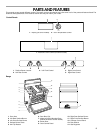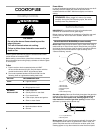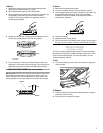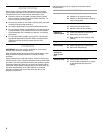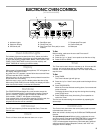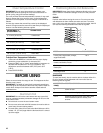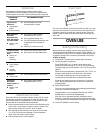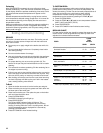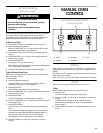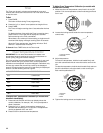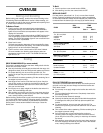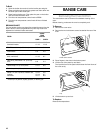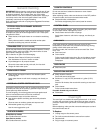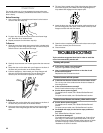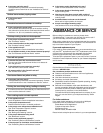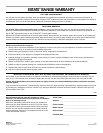
17
General Cleaning
IMPORTANT: Before cleaning, make sure all controls are off and
the oven and cooktop are cool. Always follow label instructions
on cleaning products. Do not wipe down any of the inside
surfaces until the oven has completely cooled down. Applying a
cool damp cloth to the inner door glass before it has cooled
completely could result in the glass breaking.
Soap, water and a soft cloth or sponge are suggested first unless
otherwise noted.
EXTERIOR PORCELAIN ENAMEL SURFACES
(on some models)
Food spills containing acids, such as vinegar and tomato, should
be cleaned as soon as the entire appliance is cool. These spills
may affect the finish.
■
Glass cleaner, mild liquid cleaner or non-abrasive scrubbing
pad:
Gently clean around the model and serial number plate
because scrubbing may remove numbers.
STAINLESS STEEL
(on some models)
Do not use soap-filled scouring pads, abrasive cleaners, Cooktop
Polishing Creme, steel-wool pads, gritty wash cloths or some
paper towels. Damage may occur.
Rub in direction of grain to avoid damaging.
■ Stainless Steel Cleaner & Polish (not included):
See “Assistance or Service” section to order.
■
Liquid detergent or all-purpose cleaner:
Rinse with clean water and dry with soft, lint-free cloth.
■
Vinegar for hard water spots
OVEN DOOR EXTERIOR
■
Glass cleaner and paper towels or non-abrasive plastic
scrubbing pad:
Apply glass cleaner to soft cloth or sponge, not directly on
panel.
PORCELAIN-COATED GRATES AND CAPS
Food spills containing acids, such as vinegar and tomato, should
be cleaned as soon as the cooktop, grates and caps are cool.
These spills may affect the finish.
To avoid chipping, do not bang grates and caps against each
other or hard surfaces such as cast iron cookware.
Do not reassemble caps on burners while wet.
■
Non-abrasive plastic scrubbing pad and mildly abrasive
cleanser:
Clean as soon as cooktop, grates and caps are cool.
■
Dishwasher (grates only, not caps):
Use the most aggressive cycle.
SURFACE BURNERS
Sealed Burner models
See “Surface Burners” section.
Open Burner models
See “Surface Burners” section.
COOKTOP CONTROLS
Do not use steel wool, abrasive cleansers or oven cleaner.
Do not soak knobs.
When replacing knobs, make sure knobs are in the OFF position.
On some models, do not remove seals under knobs.
■ Soap and water or dishwasher:
Pull knobs straight away from control panel to remove.
CONTROL PANEL
Do not use abrasive cleaners, steel-wool pads, gritty wash cloths
or some paper towels. Damage may occur.
■ Glass cleaner and soft cloth or sponge:
Apply glass cleaner to soft cloth or sponge, not directly on
panel.
OVEN CAVITY
Food spills should be cleaned when oven cools. At high
temperatures, foods react with porcelain and staining, etching,
pitting or faint white spots can result.
On some models, the oven door can be removed. See “Oven
Door” first.
■
Steel wool pad
■ Oven cleaner:
Follow product label instructions. Do not let cleaner contact
gasket, thermostat or exterior surfaces. Line the floor with
newspaper.
OVEN RACKS
■
Steel wool pad
BROILER PAN AND GRID
■
Mildly abrasive cleanser:
Scrub with wet scouring pad.
■
Solution of ¹₂ cup (125 mL) ammonia to 1 gallon (3.75 L)
water:
Soak for 20 minutes, then scrub with scouring or steel wool
pad.
■
Oven cleaner:
Follow product label instructions.
Porcelain enamel only, not chrome
■
Dishwasher
Oven Light
The oven light is a standard 40-watt appliance bulb. It will come
on when the oven door is open. When the oven door is closed,
press the manual oven light switch on the backguard to turn on
and off.
Before replacing, make sure the oven and cooktop are cool and
the control knobs are off.
To Replace:
1. Unplug range or disconnect power.
2. Turn bulb counterclockwise to remove from socket.
3. Replace bulb.
4. Plug in range or reconnect power.



